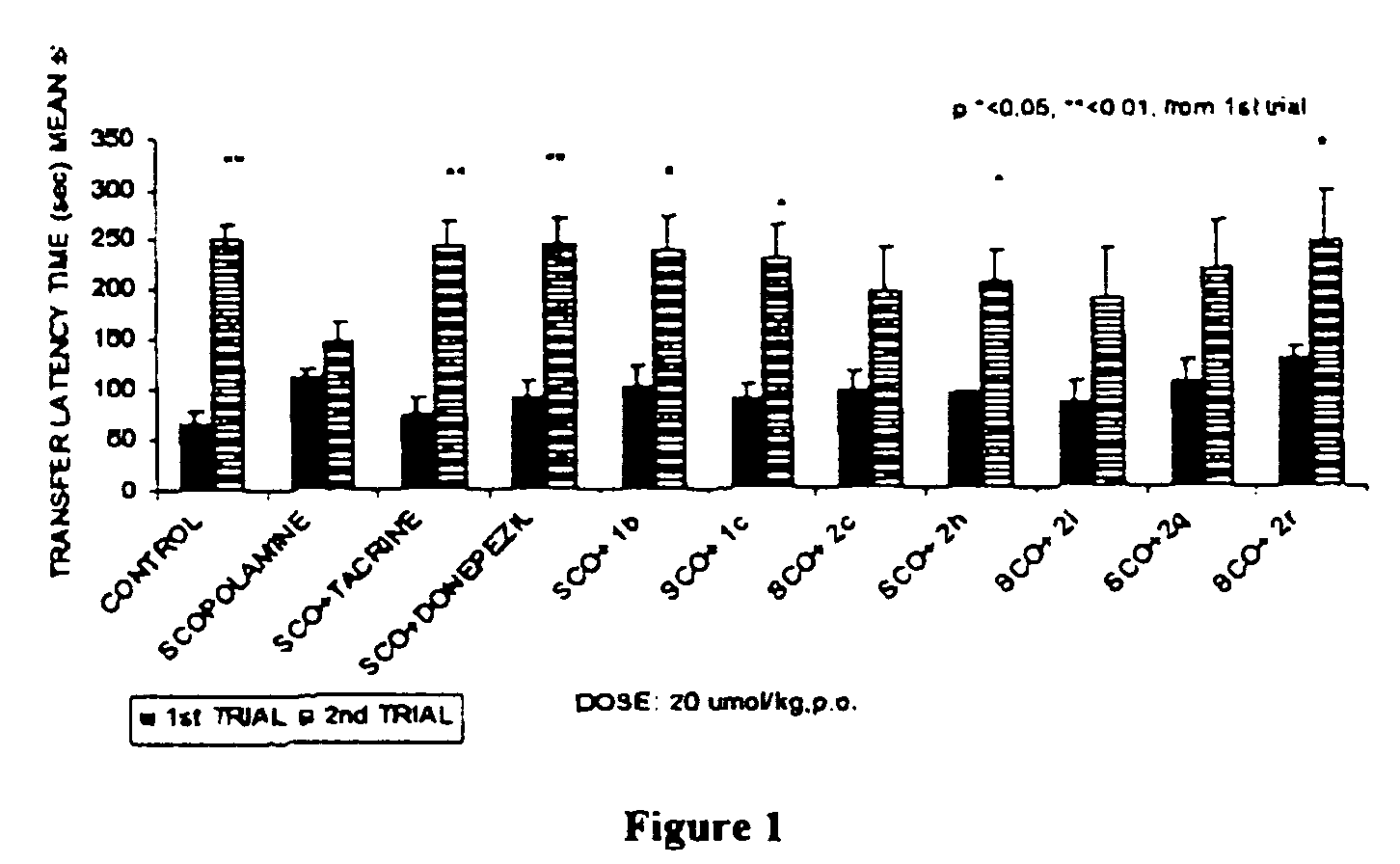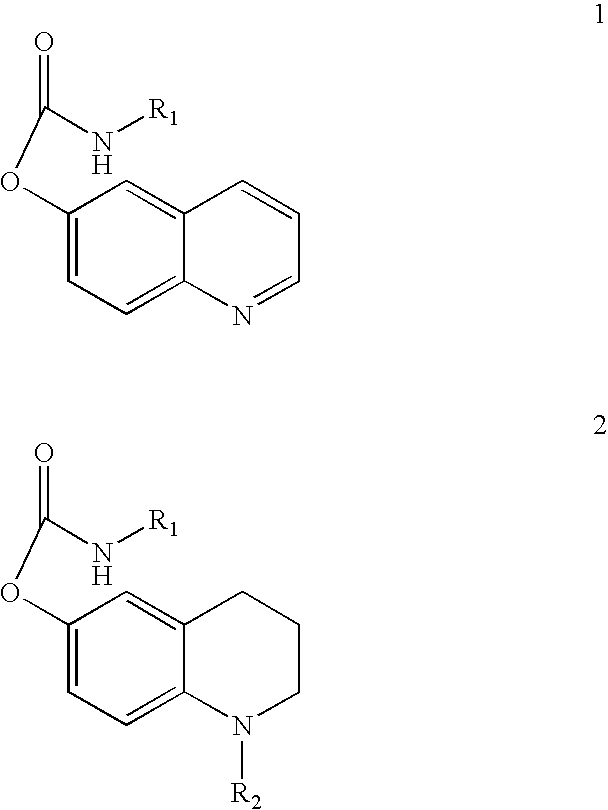Substituted carbamic acid quinolin-6-yl esters useful as acetylcholinesterase inhibitors
a technology of carbamic acid and esters, which is applied in the direction of biocide, heterocyclic compound active ingredients, organic chemistry, etc., can solve the problems of no well-approved therapy to check the progression, liver toxicity, headache, nausea, vomiting, etc., and achieve the effect of reducing blood-borne cholinesterase from the brain
- Summary
- Abstract
- Description
- Claims
- Application Information
AI Technical Summary
Benefits of technology
Problems solved by technology
Method used
Image
Examples
example 1
Hexyl-Carbamic Acid quinolin-6-yl Ester (1a)
[0144](a) Mixture of quinolin-6-ol (0.58 g., 4 mmol), dry dioxane (20 ml), hexyl isocyanate (0.698 ml, 4.8 mmol) and dry pyridine (0.2 ml) was stirred at room temperature (32° C.) for 48 hours. Reaction mixture was concentrated under vaccum, titurated with water (1 ml) and crystallised with ether, to give 1a; yield: 0.80 g. (73.5%), m.p. 89° C., C16H20N2O2; 1H NMR δ ppm (CDCl3): 0.91 (bs, 3H), 1.33-1.34 (bs, 6H), 1.56-1.62 (m, 2H), 3.24-3.34 (m, 2H), 5.21 (bs, 1H), 7.35-7.42 (m, 1H), 7.48-7.52 (m, 1H), 7.60-7.61 (m, 1H), 8.07-8.12 (m, 2H), 8.86-8.89 (m, 1H); IR vmax (KBr) (cm−1): 478, 530, 674, 730, 788, 839, 909, 970, 1002, 1040, 1158, 1215, 1258, 1300, 1356, 1462, 1495, 1543, 1709, 1919, 2373, 2861, 2961, 3032, 3286, 3346, 3777, MS: m / z: 273 (M+).
[0145](b) Mixture of quinolin-6-ol (0.58 g., 4 mmol), hexyl isocyanate (0.698 ml, 4.8 mmol) and of dry pyridine (0.3 ml) in dry dioxane (10 ml) was heated at 100° C. with stirring for 3 hours. R...
example 2
Heptyl-Carbamic Acid quinolin-6-yl ester (1b)
[0148](a) A mixture of quinolin-6-ol (0.29 g., 2 mmol), heptyl isocyanate (0.386 ml 2.4 mmol) and pyridine (1 ml) in dry tetrahydrofuran (10 ml) was heated at 65° C. with stirring for 5 hours. The reaction mixture was cooled and then quenched with water (1 ml), the reaction mixture was concentrated under vaccum and the separated solid was washed with water (2×5 ml) and crystallised with ether to give 1b; yield: 0.25 g. (43.7%), m.p. 78° C., C17H22N2O2; 1H NMR δ ppm (CDCl3): 0.88 (bs, 3H), 1.33-1.34 (m, 8H), 1.57-1.62 (m, 2H), 3.25-3.35 (m, 2H) 5.10 (s, 1H), 7.36-7.52 (m, 1H), 7.47-7.52 (m, 1H), 7.60-7.61 (m, 1H), 8.07-8.12 (m, 2H), 8.86-8.88 (m, 1H), IR vmax (KBr) (cm−1) 478, 648, 731, 771, 838, 910, 977, 1024, 1157, 1215, 1363, 1464, 1498, 1532, 1600, 1719, 2371, 2861, 2944, 3022, 3359, 3762; MS: m / z: 287 (M+).
[0149](b) A mixture of quinolin-6-ol (0.29 g., 2 mmol), heptyl isocyanate (0.39 ml, 2.4 mmol) and pyridine (2 ml) in dry tetrahyd...
example 3
2-Chloro-phenyl)-carbamic acid quinolin-6-yl ester (1c)
[0151](a) A mixture of quinolin-6-ol (0.29 g., 2 mmol), 2-chloro-phenyl isocyanate (0.33 ml, 2.4 mmol) and pyridine (0.3 ml) in dry tetrahydrofuran (5 ml) was heated at 65° C. with stirring for 5 hours. The reaction mixture was cooled, quenched with water (1 ml) and concentrated under vaccum. The separated solid was washed with water (2×5 ml) and crystallised with methanol to give 1c; yield: 0.30 g. (50.2%), m.p, 228° C., C16H11ClN2O2. 1H NMR δ ppm (pyridine d5): 6.96-7.57 (m, 9H), 8.62-8.71 (m, 1H), 9.47 (m, 1H), IR vmax (KBr) (cm−1): 903, 943, 1040, 1230, 1291, 1353, 1437, 1474, 1552, 1592, 1646, 2373, 3289, 3759.
[0152](b) A mixture of quinolin-6-ol (0.145 g., 1 mmol), 2-chloro-phenyl isocyanate (0.164 ml, 1.2 mmol), potassium carbonate (0.14 g, 1 mmol), potassium iodide (0.16, 1 mmol) g. in dry dimethylformamide (2 ml) was heated at 80° C. for 5 hours. The reaction mixture was diluted with water (5 ml), extracted with ethyl a...
PUM
| Property | Measurement | Unit |
|---|---|---|
| temperature | aaaaa | aaaaa |
| temperature | aaaaa | aaaaa |
| hydrogen pressure | aaaaa | aaaaa |
Abstract
Description
Claims
Application Information
 Login to View More
Login to View More - R&D
- Intellectual Property
- Life Sciences
- Materials
- Tech Scout
- Unparalleled Data Quality
- Higher Quality Content
- 60% Fewer Hallucinations
Browse by: Latest US Patents, China's latest patents, Technical Efficacy Thesaurus, Application Domain, Technology Topic, Popular Technical Reports.
© 2025 PatSnap. All rights reserved.Legal|Privacy policy|Modern Slavery Act Transparency Statement|Sitemap|About US| Contact US: help@patsnap.com



